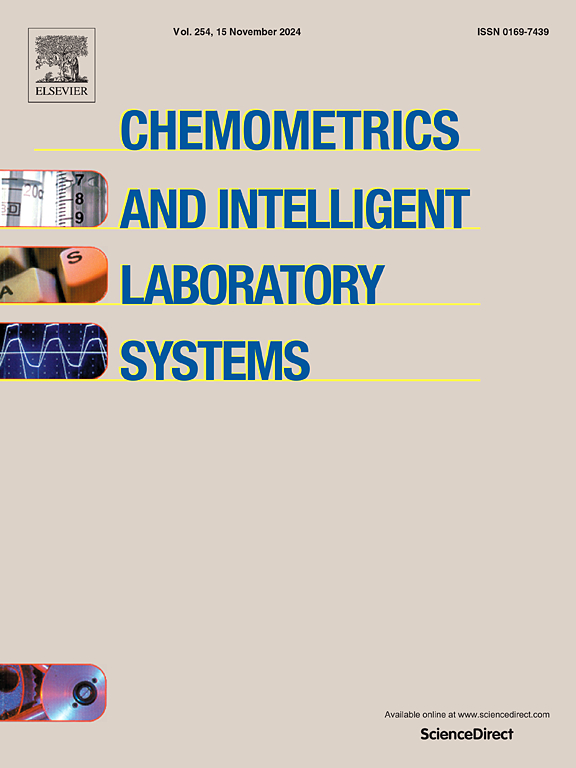桑娇维塞葡萄花色苷含量预测的颜色和质地特征提取方法比较
IF 3.8
2区 化学
Q2 AUTOMATION & CONTROL SYSTEMS
Chemometrics and Intelligent Laboratory Systems
Pub Date : 2025-05-27
DOI:10.1016/j.chemolab.2025.105446
引用次数: 0
摘要
颜色和质地是食品RGB图像中包含的两个主要信息来源。基于颜色和纹理特征的提取,可以使用不同的图像级方法来分析图像属性,选择最合适的方法是一个关键点,因为它可能会对结果产生重大影响。本研究有三个主要目标。首先,我们提出了一种创新的数据降维方法,将RGB图像的纹理特征提取并编码为一维信号,称为texturegram (TXG)。然后,将TXG方法与颜色图(CLG)、软颜色纹理描述符(SCTD)和灰度共生矩阵(GLCM)等不同的图像级特征提取方法进行了比较。这些技术被用于分析RGB图像的基准数据集,该数据集已经在之前的研究中被考虑过,以建立偏最小二乘(PLS)模型,并将图像特征与红葡萄样品的花青素含量联系起来。我们还探讨了利用数据融合将不同图像级技术所带来的颜色和纹理信息结合起来可能带来的优势。将RGB图像数据集划分为训练集和测试集,计算PLS模型。采用方差分析(ANOVA)和主成分分析(PCA)对不同模型的性能进行统计评价。总的来说,结果表明,当融合CLG和TXG时,模型性能得到了有趣的改善,即使是轻微的改善,但也突出了TXG的混合性质,同时探索颜色和纹理属性。本文章由计算机程序翻译,如有差异,请以英文原文为准。
Comparison of colour and texture feature extraction methods to predict anthocyanins content in Sangiovese grapes
Colour and texture are the two main sources of information contained in RGB images of food products. Different image-level approaches are available to analyse the image properties based on the extraction of colour and texture features, and the selection of the most appropriate method is a critical point, since it could significantly impact the outcomes. The present study has three main objectives. Firstly, we propose an innovative data dimensionality reduction method to extract and codify the texture features of an RGB image into a one-dimensional signal, named texturegram (TXG). Then, TXG approach is compared with different image-level feature extraction methods, such as colourgrams (CLG), Soft Colour Texture Descriptors (SCTD) and Grey Level Co-occurrence Matrices (GLCM). These techniques were used to analyse a benchmark dataset of RGB images already considered in a previous study to build Partial Least Squares (PLS) models and relate the image features with anthocyanins content of red grape samples. We also investigated the possible advantages of combining the colour and texture information brought by the different image-level techniques using data fusion. PLS models were calculated considering different partitions of the RGB image dataset into training and test set. The performances of the different models were statistically evaluated by means of Analysis of Variance (ANOVA) and Principal Component Analysis (PCA). Overall, the results suggested an interesting, even if slight, improvement of the model performances when fusing CLG and TXG, but also highlighted the hybrid nature of TXG to simultaneously explore colour and texture properties.
求助全文
通过发布文献求助,成功后即可免费获取论文全文。
去求助
来源期刊
CiteScore
7.50
自引率
7.70%
发文量
169
审稿时长
3.4 months
期刊介绍:
Chemometrics and Intelligent Laboratory Systems publishes original research papers, short communications, reviews, tutorials and Original Software Publications reporting on development of novel statistical, mathematical, or computer techniques in Chemistry and related disciplines.
Chemometrics is the chemical discipline that uses mathematical and statistical methods to design or select optimal procedures and experiments, and to provide maximum chemical information by analysing chemical data.
The journal deals with the following topics:
1) Development of new statistical, mathematical and chemometrical methods for Chemistry and related fields (Environmental Chemistry, Biochemistry, Toxicology, System Biology, -Omics, etc.)
2) Novel applications of chemometrics to all branches of Chemistry and related fields (typical domains of interest are: process data analysis, experimental design, data mining, signal processing, supervised modelling, decision making, robust statistics, mixture analysis, multivariate calibration etc.) Routine applications of established chemometrical techniques will not be considered.
3) Development of new software that provides novel tools or truly advances the use of chemometrical methods.
4) Well characterized data sets to test performance for the new methods and software.
The journal complies with International Committee of Medical Journal Editors'' Uniform requirements for manuscripts.

 求助内容:
求助内容: 应助结果提醒方式:
应助结果提醒方式:


